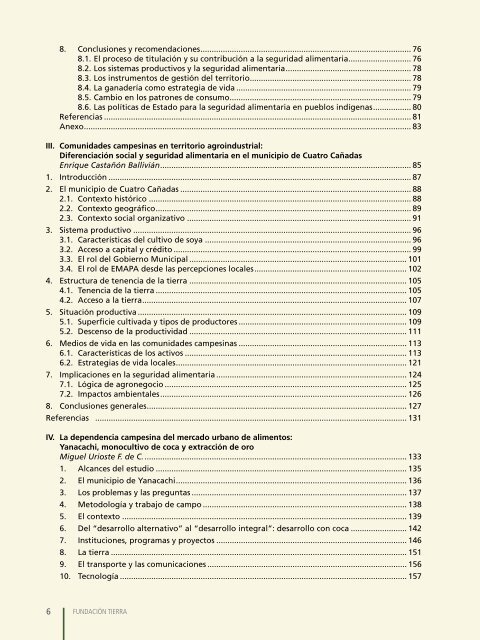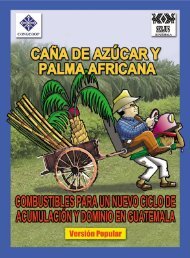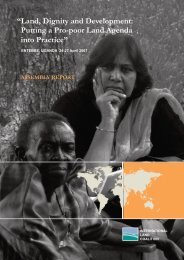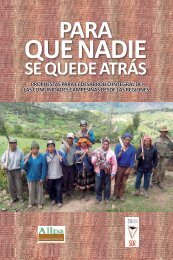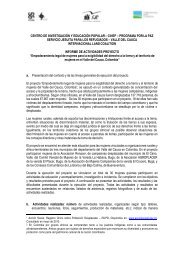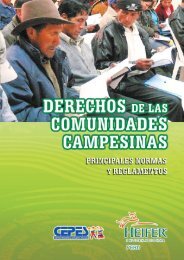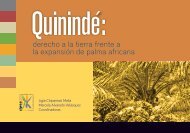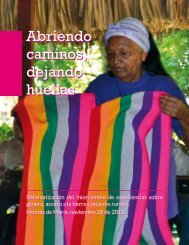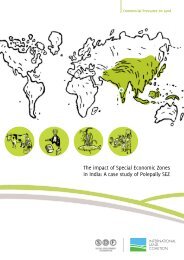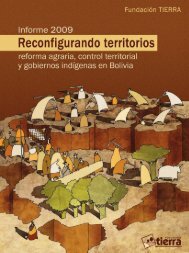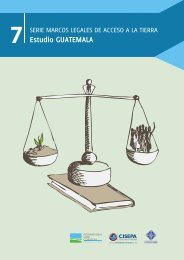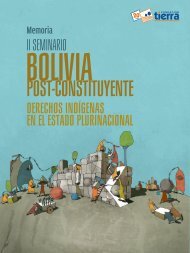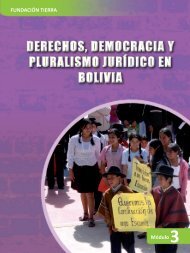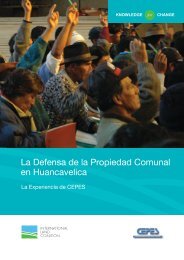¿Comer de nuestra tierra?
Descargar - International Land Coalition
Descargar - International Land Coalition
- No tags were found...
You also want an ePaper? Increase the reach of your titles
YUMPU automatically turns print PDFs into web optimized ePapers that Google loves.
8. Conclusiones y recomendaciones............................................................................................... 76<br />
8.1. El proceso <strong>de</strong> titulación y su contribución a la seguridad alimentaria............................. 76<br />
8.2. Los sistemas productivos y la seguridad alimentaria......................................................... 78<br />
8.3. Los instrumentos <strong>de</strong> gestión <strong>de</strong>l territorio......................................................................... 78<br />
8.4. La gana<strong>de</strong>ría como estrategia <strong>de</strong> vida............................................................................... 79<br />
8.5. Cambio en los patrones <strong>de</strong> consumo.................................................................................. 79<br />
8.6. Las políticas <strong>de</strong> Estado para la seguridad alimentaria en pueblos indígenas.................. 80<br />
Referencias.......................................................................................................................................... 81<br />
Anexo................................................................................................................................................... 83<br />
III. Comunida<strong>de</strong>s campesinas en territorio agroindustrial:<br />
Diferenciación social y seguridad alimentaria en el municipio <strong>de</strong> Cuatro Cañadas<br />
Enrique Castañón Ballivián................................................................................................................. 85<br />
1. Introducción........................................................................................................................................ 87<br />
2. El municipio <strong>de</strong> Cuatro Cañadas........................................................................................................ 88<br />
2.1. Contexto histórico...................................................................................................................... 88<br />
2.2. Contexto geográfico................................................................................................................... 89<br />
2.3. Contexto social organizativo..................................................................................................... 91<br />
3. Sistema productivo............................................................................................................................. 96<br />
3.1. Características <strong>de</strong>l cultivo <strong>de</strong> soya............................................................................................. 96<br />
3.2. Acceso a capital y crédito........................................................................................................... 99<br />
3.3. El rol <strong>de</strong>l Gobierno Municipal.................................................................................................. 101<br />
3.4. El rol <strong>de</strong> EMAPA <strong>de</strong>s<strong>de</strong> las percepciones locales..................................................................... 102<br />
4. Estructura <strong>de</strong> tenencia <strong>de</strong> la <strong>tierra</strong>.................................................................................................. 105<br />
4.1. Tenencia <strong>de</strong> la <strong>tierra</strong>................................................................................................................. 105<br />
4.2. Acceso a la <strong>tierra</strong>....................................................................................................................... 107<br />
5. Situación productiva......................................................................................................................... 109<br />
5.1. Superficie cultivada y tipos <strong>de</strong> productores............................................................................ 109<br />
5.2. Descenso <strong>de</strong> la productividad.................................................................................................. 111<br />
6. Medios <strong>de</strong> vida en las comunida<strong>de</strong>s campesinas............................................................................ 113<br />
6.1. Características <strong>de</strong> los activos.................................................................................................... 113<br />
6.2. Estrategias <strong>de</strong> vida locales........................................................................................................ 121<br />
7. Implicaciones en la seguridad alimentaria...................................................................................... 124<br />
7.1. Lógica <strong>de</strong> agronegocio............................................................................................................. 125<br />
7.2. Impactos ambientales............................................................................................................... 126<br />
8. Conclusiones generales..................................................................................................................... 127<br />
Referencias ............................................................................................................................................ 131<br />
IV. La <strong>de</strong>pen<strong>de</strong>ncia campesina <strong>de</strong>l mercado urbano <strong>de</strong> alimentos:<br />
Yanacachi, monocultivo <strong>de</strong> coca y extracción <strong>de</strong> oro<br />
Miguel Urioste F. <strong>de</strong> C....................................................................................................................... 133<br />
1. Alcances <strong>de</strong>l estudio................................................................................................................. 135<br />
2. El municipio <strong>de</strong> Yanacachi........................................................................................................ 136<br />
3. Los problemas y las preguntas................................................................................................. 137<br />
4. Metodología y trabajo <strong>de</strong> campo............................................................................................ 138<br />
5. El contexto................................................................................................................................ 139<br />
6. Del “<strong>de</strong>sarrollo alternativo” al “<strong>de</strong>sarrollo integral”: <strong>de</strong>sarrollo con coca.......................... 142<br />
7. Instituciones, programas y proyectos...................................................................................... 146<br />
8. La <strong>tierra</strong>..................................................................................................................................... 151<br />
9. El transporte y las comunicaciones.......................................................................................... 156<br />
10. Tecnología................................................................................................................................. 157<br />
6<br />
FUNDACIÓN TIERRA


